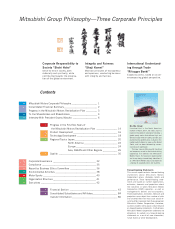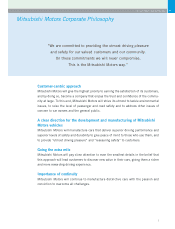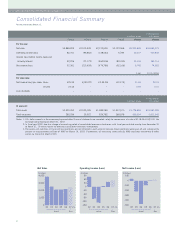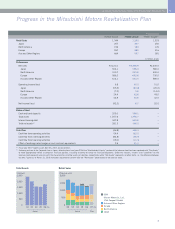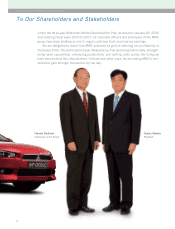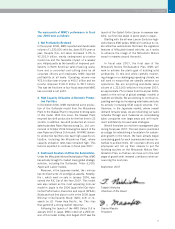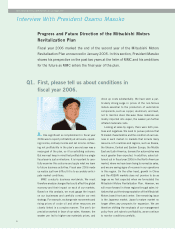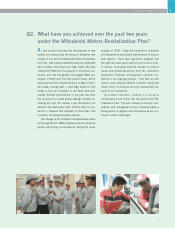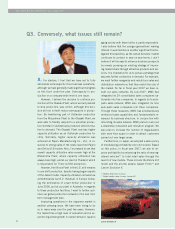Mitsubishi 2007 Annual Report Download - page 8
Download and view the complete annual report
Please find page 8 of the 2007 Mitsubishi annual report below. You can navigate through the pages in the report by either clicking on the pages listed below, or by using the keyword search tool below to find specific information within the annual report.
MITSUBISHI MOTORS CORPORATION Annual Report 2007
6
Progress and Future Direction of the Mitsubishi Motors
Revitalization Plan
Fiscal year 2006 marked the end of the second year of the Mitsubishi Motors
Revitalization Plan announced in January 2005. In this section, President Masuko
shares his perspective on the past two years at the helm of MMC and his ambitions
for the future as MMC enters the final year of the plan.
A. One significant accomplishment in fiscal year
2006 was to report profitability at all levels: operat-
ing income, ordinary income and net income. Achiev-
ing net profitability in the plan’s second year was a
major goal of the plan, so it’s a satisfying outcome.
But we must keep in mind that profitability in a single
fiscal year is just a milestone. It is important to care-
fully examine this outcome and apply what we learn
to future business activities. Fiscal year 2006 made
us realize just how difficult it is to accurately antici-
pate market conditions.
MMC conducts business worldwide. We must
therefore analyze changes that could affect the global
economy and their impact on each of our markets.
Based on this analysis, we must gauge the impact
on our businesses and carefully consider our next
strategy. For example, exchange rate movements and
rising prices of crude oil and other resources are
closely linked in a complex manner. The yen’s de-
preciation worked in favor of our sales. However, the
weaker yen led to higher raw materials prices, and
Q1. First, please tell us about conditions in
fiscal year 2006.
Interview With President Osamu Masuko
drove up costs substantially. We have seen a par-
ticularly strong surge in prices of the non-ferrous
metals essential to the production of automobile
components, such as copper, aluminum, and lead,
not to mention steel. Because these materials are
mostly imported into Japan, the weaker yen further
inflated materials costs.
Looking at sales by region, there were both posi-
tives and negatives. We need to pursue policies that
fit market characteristics and the condition of our busi-
ness in each market. In markets that include many
resource-rich countries and regions, such as Russia,
the Ukraine, Central and Eastern Europe, the Middle
East and Latin America, demand for automobiles was
much greater than expected. In addition, sales bot-
tomed out in fiscal year 2006 in the North American
market, where we have been trying to normalize sales,
and we are seeing signs of recovery in our operations
in this region. On the other hand, growth in China
and the ASEAN markets does not promise to be as
large as we first expected when we formulated the
Mitsubishi Motors Revitalization Plan. However, we
will move forward in these regions through sales ini-
tiatives that put the strong reputation of the Mitsubishi
Motors brand front and center. One remaining issue
is the Japanese market. Japan’s mature market no
longer offers any prospects for expansion. We are
therefore shifting the emphasis of our management
policy from unit sales to profitability, as we continue
to monitor conditions carefully.


